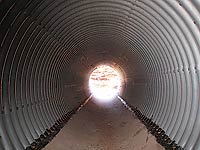 A canyon that starts at a culvert, an arch with the configuration of a jeep – put them all together and what do you get? – Culvert Canyon and Jeep Arch. If you think this is an Alice In Wonderland story line, think again. You really do have to walk through a long culvert to enter this canyon - the most commonly used access to Jeep Arch, which is sometimes referred to as Gold Bar Arch.
A canyon that starts at a culvert, an arch with the configuration of a jeep – put them all together and what do you get? – Culvert Canyon and Jeep Arch. If you think this is an Alice In Wonderland story line, think again. You really do have to walk through a long culvert to enter this canyon - the most commonly used access to Jeep Arch, which is sometimes referred to as Gold Bar Arch.
The entrance to Culvert Canyon, also known as Dragonfly, isn’t far from Moab. To get there drive 4.2 miles north on Highway 191 and turn left on Utah 279 (Potash Road). Then drive 10.5 more miles. Just beyond the Corona Arch trailhead at mile marker five, pull off the road and park at the end of the culvert.
On this refreshingly cool morning, I am savoring my early bird, beat-the-crowd start. Not a soul is stirring as I climb up to the culvert and enter its cavernous interior under the railroad tracks for an eerie walk to the light-at-the-end-of-the tunnel experience.
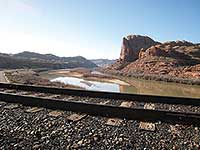 When I return to the light of day and step out on a soft, squishy layer of sand, a prominent sign marks the beginning of the two mile, hiking-only trail to Jeep Arch. For a short distance an abandoned cattle trail takes you out of the canyon along a drainage where a rush of water sometimes flows. What a huge difference even a small collection of moisture can create - a cornucopia of native grasses, prickly pear cactus, saltbush, Mormon tea and the fresh growth of Prince’s plume - a brushy seedy bonanza that attracts a big flock of juncos, who constantly dart in and out of their thick protective sanctuary.
When I return to the light of day and step out on a soft, squishy layer of sand, a prominent sign marks the beginning of the two mile, hiking-only trail to Jeep Arch. For a short distance an abandoned cattle trail takes you out of the canyon along a drainage where a rush of water sometimes flows. What a huge difference even a small collection of moisture can create - a cornucopia of native grasses, prickly pear cactus, saltbush, Mormon tea and the fresh growth of Prince’s plume - a brushy seedy bonanza that attracts a big flock of juncos, who constantly dart in and out of their thick protective sanctuary.
The drainage ends at the railroad tracks, where sweeping vistas of the Colorado River and its accompanying canyons put in a brief appearance. But very quickly a switchback - the only one on the entire trail – swings sharply upward toward the bench above Culvert Canyon. Once on top the tricky part begins as I keep searching for the stacked rocks called cairns that mark the route. Placed far apart over a long swath of gray slickrock, they are difficult to see, and it takes a fair bit of scouting to stay on course. By trial-and-error I learn not to stray too far from the rim, a strategy that has the added advantage of catching enchanting glimpses of the cottonwoods and mysterious pools deep within the canyon.
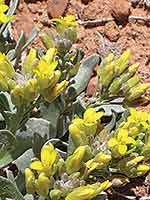 Gradually the pathway becomes more defined, freeing me to concentrate on the fresh yellow blooms of Newberry twinpod - one of the first flowers of spring - as well as the towering wall of sandstone shooting down from the Gold Bar Rim – the sharp edges of Culvert’s rim - and the huge conglomeration of cliffs and domes coming at me from all directions.
Gradually the pathway becomes more defined, freeing me to concentrate on the fresh yellow blooms of Newberry twinpod - one of the first flowers of spring - as well as the towering wall of sandstone shooting down from the Gold Bar Rim – the sharp edges of Culvert’s rim - and the huge conglomeration of cliffs and domes coming at me from all directions.
A twisty passage around a mini-canyon – and suddenly there it is – a distinctive landmark of darker colored sandstone that I call “The Spire” with a humungous dome of lighter colored rock hanging off to the right. At this point the trail splits into a loop, with an upper and lower route to Jeep Arch. I choose the upper, which goes directly to the base of The Spire. Once again there is no obvious route, and it is a grunt scrambling over rocks and up ledges, but with The Spire as my guide it doesn’t take a rocket scientist to find the way! After that daunting workout, I plop down for a break and a chance to study the wide girth and gigantic stature of this astounding structure.
Eventually I muster up the energy to continue on, and what a joy it is to cruise easily along a level, soft dirt trail across a huge playa of blackbrush. At this faster pace the profile of a jeep quickly pops into view, and its jagged, fractured edges make it look like the Jolly Green Giant punched out a big 66 foot wide hole. As huge as it is, the arch is dwarfed by the immensity of its base – a huge semi-circle slab of sandstone. To walk around this extensive structure would take a big chunk of time out of your afternoon! 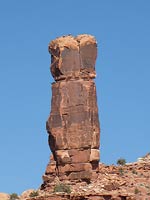
Geologists believe that most of our arches were created within the last million years and have survived to this day because the Colorado Plateau is relatively free of earthquakes. The formation of an arch generally occurs at the weakened points in Wingate, Navajo and Entrada Sandstone. Water dissolves the chemical cement that binds the sandstone. Then freezing expands the fractures to continue the arch making process. Once the opening is formed, it is slowly enlarged by a combination of erosion and internal stress forces, until an arch such as Jeep is born.
Almost there, the easy-going part abruptly comes to a halt at a miniature rock wall. But footholds are good, everything feels secure and up I go to the final section on a very narrow ledge to the arch. At this spot I am very careful not to get distracted. A nasty fall off the edge would be a foolish thing to do!
Phew! I’ve made it! And what a view – to the north through this open-air, rock-framed window, a cerulean sky highlights the snow-mantled La Sals. Then turning my attention southeast I peer down on a mind-boggling vista - a massive jumble of boulders strewn over elongated stretches of slickrock. It creates the illusion of a gigantic jigsaw puzzle that will never fit together - a geological maze of pillars, mesas, slabs, fins and domes – a conglomeration of mounded, rounded, knife-edge, upended and jagged configurations as far as the eye can see!
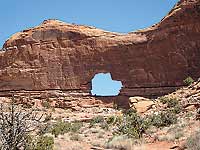 At this marvelous location I happily settle down for a leisurely lunch - thrilled to experience this expansive overwhelming scene. It was worth every minute of the hard hike and scramble to get here! And what’s more, the difficult part is over – the loop on the north side of the arch is an easy downhill all the way back!
At this marvelous location I happily settle down for a leisurely lunch - thrilled to experience this expansive overwhelming scene. It was worth every minute of the hard hike and scramble to get here! And what’s more, the difficult part is over – the loop on the north side of the arch is an easy downhill all the way back!
If you have a shorter hike in mind, wandering to your heart’s content through Culvert Canyon until it ends at a huge pour off is a pleasurable excursion. Forging on to Jeep Arch is more of an adventure – a challenge that is so satisfying when you do find your way to this well-known, uniquely shaped landmark - especially now that a brand new trail makes it much easier than it was before.